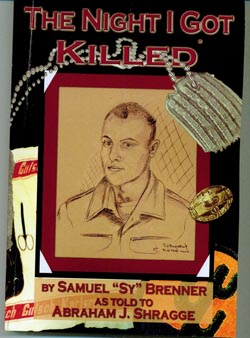The Night I Got Killed by Samuel “Sy” Brenner as told to Abraham J. Shragge, self published, ISBN 978-0-557-68964-4, Price not listed, available via www.sybrenner.com
By Donald H. Harrison

SAN DIEGO –With Veterans Day slightly more than a month away, Sy Brenner finally has the pleasure of seeing his remarkable memoir in print—thanks to the help of former UCSD History Prof. Abraham Schragge, who now is teaching in South Korea. The two men painstakingly collaborated on this book, with Sy providing the memories and Abe meticulously verifying dates and places. It has been some 65 years since the war ended, and although some memories are indelible, they sometimes can run together.
 Brenner, Jewish, served in the European theatre, and when Germans found his body after an explosion had rendered him unconscious, they might have finished him off – but for one lucky break for Brenner that unlucky night. Someone broke his dog tag in half, throwing away the lower section with its little “H” identifying his religious background as “Hebrew.” Keeping Jews alive—whether American or from any other country – was not a priority of the Germans during the Nazi regime.
Brenner, Jewish, served in the European theatre, and when Germans found his body after an explosion had rendered him unconscious, they might have finished him off – but for one lucky break for Brenner that unlucky night. Someone broke his dog tag in half, throwing away the lower section with its little “H” identifying his religious background as “Hebrew.” Keeping Jews alive—whether American or from any other country – was not a priority of the Germans during the Nazi regime.
Not long after Brenner recuperated from his wounds, the Germans learned that he was a medic. In other words, he was qualified to administer first aid, and to help transport people to hospitals. But having no doctors among the prisoners at Brenner’s stalag, they made him serve as a doctor and surgeon, providing only minimal supplies.
The horrific war injuries that Brenner was called upon to treat – including one requiring a leg amputation, which was nearly more terrible for him than for the patient— still give Brenner nightmares. So do some of the sadistic “tricks” that his German captors played on him, especially the time they locked him in a closet with a corpse for several days.
On top of these problems, Brenner always was concerned that the Germans would somehow learn that he was a Jew, and take him outside the camp to be shot. He became especially paranoid when a soldier he had recognized as an anti-Semite from their days together stateside was brought to the camp. But however much that soldier hated Jews, he apparently hated his captors more – so kept his mouth shut.
In the prison camp’s small medical dispensary, Brenner met soldiers of many Allied nations. In fact, the dispensary became a meeting place for prisoners who somehow had made contact with the Resistance Movement inside the Third Reich. Brenner was recruited into the cell of resisters, and one time he figured his end surely had come. That night a German guard, who was particularly sadistic, roughly pushed him out of the dispensary and ordered him to march outside the prison.
Once out of the line of sight of other guards, however, this guard’s attitude changed. Although a German soldier, he disapproved of the Nazis, and took Brenner to a rendezvous, where he met with the “Lady,” the wife of a high-ranking German officer who had news for him to bring back to the resistance cell in the prison. Brenner’s fellow prisoners, in turn, would pass the sealed information onto their contacts among the Allies.
In retrospect, Brenner’s war time life was the stuff of a movie script, except that it was real. Now in his late 80’s, Brenner’s nightmares – which today are called symptoms of Post-Traumatic Stress Disorder – remain unabated.
The veteran has been nominated by the local Prisoner of War/ Missing in Action unit this year as Veteran of the Year, an award that is conferred by a confederation of Veterans groups that is headquartered at the Veterans Memorial Museum in Balboa Park, where history professor Schragge once served as curator.
For making the horror and the strange circumstances of World War II understandable to modern-day readers, Brenner surely will receive serious consideration for this honor.
*
Harrison is editor of San Diego Jewish World
Pingback: Samuel Seymour "Sy" Brenner, 1922-2015 - San Diego Jewish World
Pingback: World War II POW Sy Brenner to be Cuyamaca’s Veterans Day speaker « GCSummit